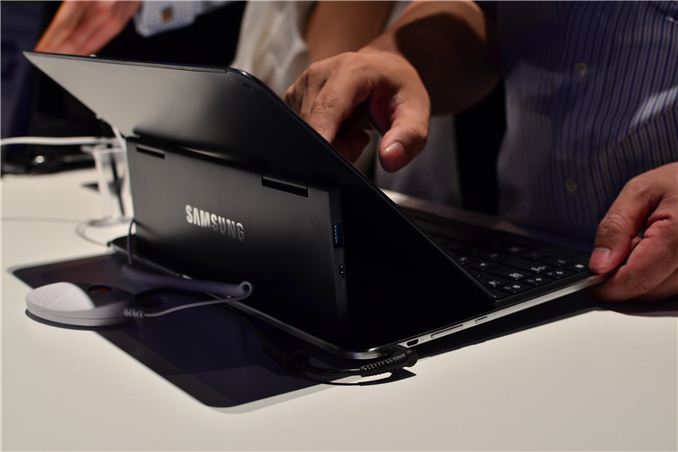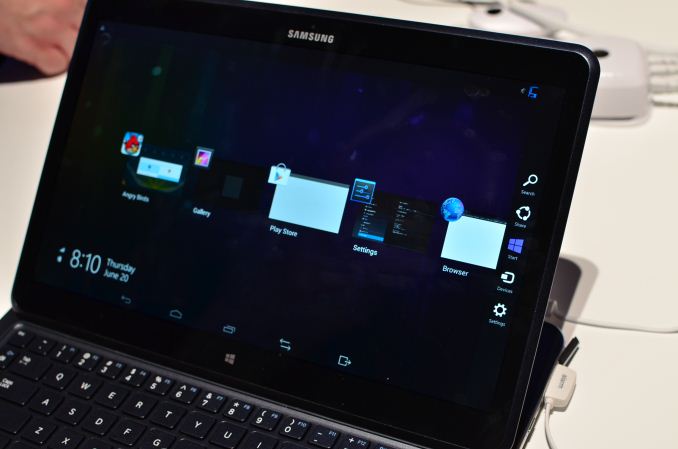Samsung ATIV Q Hands On: 3200 x 1800 13.3" Tablet Running Windows 8 and Android
by Anand Lal Shimpi on June 20, 2013 3:16 PM EST
We just finished playing with Samsung's newly announced ATIV Q, a convertible tablet that runs both Windows 8 and Android 4.2.2. The display is the main attraction. The 13.3" panel features a 3200 x 1800 resolution (276 PPI). Although some of the screen shots from Samsung's presentation of the ATIV Q showed Windows 8.1 running, the demo units themselves ran vanilla Windows 8 and as a result had to rely on traditional Windows DPI scaling. I fully expect Windows 8.1 to make this 3200 x 1800 13.3" panel usable through new OS X-like DPI scaling upon its release.
Despite having to light 5.76 million pixels, the ATIV Q seemed bright indoors. The demo tablets were running at max brightness to begin with, which was comfortable (but not too bright at all). I'd be very curious to test outdoor brightness performance.
Internally the demo ATIV Q features a Core i5-4200U (Haswell ULT, dual-core + Hyper Threading, 2.6GHz max turbo, 3MB L3, Intel HD 4400). The demo systems featured 4GB of DDR3L. Powering the system is an integrated 47Wh battery.
The dual-OS functionality is what you'd expect: Android runs in a VM on top of Windows 8. Networking, storage and CPUs are all virtualized resources. Virtualization is the only way to enable Samsung's instant switching between Windows 8/Android on a single set of hardware. The switching process itself is pretty quick as Android is treated like another application running on Windows 8. Performance within Android seemed good enough, the UI wasn't butter smooth however. I'm not all that sure about the benefits of running Android on top of full blown Windows 8, but the option is there. There's even a dedicated key on the keyboard to switch between OSes.
Although the ATIV Q has a large surface area for a tablet, the overall design feels very light and portable. Lifting the display up to reveal the integrated keyboard is simple enough. The keyboard itself feels decent, although there's no room for a standard trackpad so you're left with a little nub that is reminiscent (but no where near as functional) as what you'd find on an old ThinkPad. You glide your finger over the nub to move the mouse, with slim physical buttons at the edge of the keyboard for left/right click. Touching the display is definitely the way to go, but the ATIV Q absolutely needs Windows 8.1 style DPI scaling in order to make UI widgets in desktop mode better for touch.
Hidden in the display hinge is a USB 3.0 port, micro HDMI and a micro SD card reader.
I'm a big believer in convertibles. I don't know that anyone has gotten it perfect with design yet, but it's very good to see everyone trying. Battery life is a big unknown, as is pricing - that display can't be cheap. Given its light weight construction, the ATIV Q seems like it could actually be a very compelling option.



















52 Comments
View All Comments
HumanizerDroid - Thursday, June 20, 2013 - link
This looks great! the use of both windows and android is a big +. Its light weight, thin and very good screen resolutions all are too. Battery life may let it down, but if it doesn't, more than likely Samsung's best product; and for that reason, its going to be expensive. Would definitely consider buying if under a grand. But i reckon £1299 maybe after a month trading £1199. A1 product this!apinkel - Friday, June 21, 2013 - link
Sounds like Samsung still has work to do on the hardware as well as the OS to OS integration from the sounds of it. Microsoft needs to get the resolution scaling right with 8.1 as well as the various other tweaks they've discussed to date.I think this is a good sign though. Everyone is doing what they can with what they have available to them. Progress, however imperfect, is better than not doing anything.
McD - Friday, June 28, 2013 - link
" the use of both windows and android is a big +." Why? Because they can't rustle up more than a dozen genuine tablet apps between them? How ridiculous do Android stretchies look on a 3K screen?Kidster3001 - Wednesday, July 3, 2013 - link
Android apps running across different resolutions don't look all that bad. Android does it better than Apple in this regard.Mountainjoy - Thursday, June 20, 2013 - link
Trying to think of an Android App I would want to run on a tablet that does not have a better Windows alternative or could simply be done in a real web browser. Not coming up with anything. Maybe a couple games, but if that 4400HD is better then a 4000HD, then it should be capable of 1600x900 gaming. Real games, not Fruit Ninja.WhitneyLand - Friday, June 21, 2013 - link
How about Instagram? Not on Windows 8, and last time I checked you couldn't even create an IG account via the web. Also there are lots of nice mobile games that doesn't exist for Win8. Then there are specialty apps for Home Automation and such that are far more prevalent on Android. Etc, etc.sheh - Thursday, June 20, 2013 - link
Is there a strange physical law preventing >17" and <27" monitors from having DPI > 100?That Asus 27" 4K monitor is the closest, but I'm still waiting for 24".
Mountainjoy - Thursday, June 20, 2013 - link
Yeah Im scratching my head at that. 3840x2160 at 27inch just a display, $3799, 3800x1600 at 13.3inch + Intel SOC, Mobo, Ram.... and you know it's not going to get above $1500 at the low end. Desktop users are getting shafted.ShieTar - Friday, June 21, 2013 - link
Its more complicated and expensive to produce larger screens, and with any new technology this can easily come down to "too expensive" for a lot of products. We are likely looking into 500$ worth of a 13" screen here, which barely works for a high-class notebook. On the other hand, a large screen for 3k$ or more might also attract some enthusiast early adopters. A 1500$ 24" screen will most likely not find any buyer at all, so don't expect those things to come until the screen suppliers have significantly improved their high-DPI process.WhitneyLand - Friday, June 21, 2013 - link
Helpful reply ShieTar. I think one side effect will be that 4k TVs become common faster than 2k TVs did. Simply because the overall demand, scale, and breadth of usage is larger this time around.